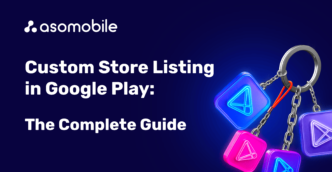What is app indexing?
Is there life on Mars? Why did dinosaurs become extinct? What is app indexing? In this guide, we undertake to answer the last question since the first two are rhetorical.
We will tell you why application indexing is the primary task of text optimization. Let's understand the concepts associated with indexing - keywords and their relevance, user queries and store search results, ranking factors, and app visibility. Let's look at app indexing through the eyes of the user and from mobile stores. It will be interesting, useful, and understandable. Are you ready to get indexed?
App indexing - basic concepts and terms
One concrete example is better than a hundred puzzling explanations.

Let's say our user wants to meditate while listening to appropriate music. They go to the mobile market and enter their query into the search bar - sounds of nature.
The store's algorithm searches for the phrase “sounds of nature” among its apps. It searches, finds, and displays what our users see. Usually, these are several applications. From these apps discovered by the store, the users choose what they like.
In the example we looked at:
- “sounds of nature”—keyword, key query, key. This is a relevant word or phrase that characterizes and describes the application and its functions.
- Relevance is about the correspondence between what was sought and what was found. That is, based on the user’s key request, the store provided applications with natural sounds. This is relevant, for which, by the way, the store is not responsible but the ASO manager or developer. The app is interested in its metadata being filled with relevant keywords, by which the store will find it and return it to a user request, like red flags.
- indexing is the process of the market searching for apps whose metadata contains the user’s key query “sounds of nature.” The market will search using the above-mentioned red flags and relevant keywords.
- a new concept emerges from relevant keys and their indexing - app visibility - this is the position of the app in the store’s search results. In our example, these are 4-5 lines in the general list - excellent visibility, taking into account that the first three lines were occupied by advertising apps. Visibility is how an app is visible to the user and an important point of the app for ASO efforts. In the current example, replacing the key and relevant query “nature sounds” with “nature chords” would reduce the visibility of the application for the user. Indexing (the search itself) would be carried out only by “nature” and the application would be ranked lower than other applications that have everything in order with the relevant key “sounds of nature”. On the one hand, the use of “chords” distinguishes the application from similar ones, but on the other hand, “chords” is not a relevant word and generally reduces the visibility of the application.
There are never too many examples.
Please note that the first three search selection positions are advertisements. Here you can learn more about advertising campaigns, their benefits and how to use them in ASO.
- Taxi

The Bolt application is a good example of selecting and using relevant keywords. The application uses not only “taxi”, but also “request”. “Request” is also present in the name of the application as part of the word “request”. The same “request” is stated in the application description. After advertising positions, Bolt appears in the third line of search results for two user queries - taxi and taxi request.
- Health

The "Lose weight app for woman" app also worked well on the relevance of keywords. Without taking into account advertising results, for the search query “lose weight” Google Play gives them the second position, and for “diet” it is the third. In the description of the application there is a declination of the key - “ lose weight ”, which brings additional indexing by the store.
- Tools

This application will definitely help you count anything, it is literally teeming with the relevant key “counter” in all possible declinations and all available metadata fields (title, short description, full description). Therefore, the store gives them second place, after paid content. But the best is the enemy of the good. Be restrained, overspam is not professional and generally bad manners.
We have already linked into one whole - the key query, its indexing and, depending on both of them, the visibility of the application. It's time to go back to basics and talk about the location of keywords - metadata.
Metadata
Metadata is all the text that describes the app and its features. It is in this text that the keywords are located. Google Play and the App Store have slightly different metadata requirements. It is worth considering this difference in text optimization of apps, the purpose of which is to increase indexing and, therefore, visibility for the user.
A short digression about indexing and ranking.
Ranking is a set of factors by which stores evaluate an app and assign a place in their ratings according to this rating. The closer the position in these ratings is to the first line, the more visible the application is to the user.
There are many ranking factors, but in general they are divided into internal and external. Internal is metadata.
So the ranking factor is the metadata, and the indexing of keywords in the metadata is the ranking result.
It is the internal ranking factors and their indexing by relevant keys that will be discussed in the table below.

Remember that there are more ranking factors than are listed in this table. There are also external ones - installations, income, application deletions, ratings and reviews, updates, backlinks. You can read about them here.
A little more about keywords
In this article, we have already written many times about keywords, but not about their types. The time has come, the keywords are conditionally divided:
- by traffic
- high frequency
- mid-frequency
- low frequency
- by length
- long (3 or more words, phrases)
- short (2 or fewer)
- according to the ASO sense
- relevant
- irrelevant
Text optimization operates with keywords (there is also visual optimization, but not about that now).
Text optimization, oddly enough, optimizes (improves) the indexing of an application by a relevant pool of keywords and consists of three main stages:
- collecting the semantic core
- prioritizing keywords
- compiling metadata
You can read a detailed guide on keywords here, but in the meantime, we will share our experience in selecting keywords.
- Logic and common sense are our first assistants in forming a key pool, simply because we are also people, also users, and no one knows our product better than us. Let's think about our application from the point of view of a user unknown to us. How would he search for our app? What words would you use to search?
Come on the other side, how does our app make the user’s life easier, what does it offer, how does it entertain, and how is it useful?
- Competitor analysis, why not? Firstly, this way we will get to know our competitors. And you should know them by sight, in our case, by icon. Secondly, by analyzing their metadata we will already find a certain number of keywords that are relevant for our application. And finally, thirdly, we will have a great opportunity not to repeat the mistakes of our competitors. They say that you can only learn from personal experience, but competitor analysis brilliantly refutes this statement.
- Suggestions are “Guess the song” game, only instead of a TV presenter there are marketplaces. An algorithm that predicts the entire word based on the first letters entered into the search string. Suggestions make life easier for rather lazy mobile users. Lazy, because there are no informational (long) queries on mobile stores. They only look for specific things and therefore use short queries. We can also use this algorithm and see what users are looking for in terms of our keywords.
- We recommend using ASA (Apple Search Ads) if the semantic core is too sparse. This happens in new or unpopular niches or in niches with branded results. You can look for additional keys here. Pay attention to the ASA index. It speaks about the popularity of the search query (5 - generally unpopular, 100 - accordingly, very, very popular).
- ASO analytics tools will do the boring and painstaking work for us. We are talking about quantitative metrics that help you select relevant keywords. How many users enter the key we need per day? What about our competitors, what search query are they indexed for? You will find answers to these and other interesting questions in App Keywords and Keyword Monitor from ASOMobile.
Tools for app indexing analysis
The simplest thing we can do to evaluate indexing is to enter a search query into the store and scroll through the search results to find our app. But analytical tools have long replaced boring parsing and provide us with information about the market, competitors, traffic, position in search results just here and now.

App Keywords - this is where we come in search of an answer to the question of what keywords our app is indexed by. What keywords from the metadata were we able to hook users and the app store at the same time?

Keyword Monitor - here we are already observing not just indexing, but the state of our semantic core. We can see by what words it occurred, in what place and what happens to our positions in search results.
Of course, analytics is not limited to these two tools, but for working with indexation assessment, they have no equal.
Final word
Once you pull the right thread, everything immediately becomes clear and simple. At first, of course, it doesn’t seem so, because when formulating the very concept of indexing, it is necessary to introduce accompanying terms and definitions - keywords, relevance, ranking, metadata. Then these keywords still need to be defined and selected, and then the semantics with ASO tools are tightened up. The topic of indexing keywords is so voluminous because it is a priority (after all, in the beginning there was a word). The most amazing, high-quality, necessary and useful application will remain unnoticed by users if its keywords are not relevant and therefore not indexed by the store.
We hope that we were able to untie this knot and extract from it the very guiding thread with which the indexing of the application begins. We will return to this guide if necessary and may only relevant keywords come with us.
 Українська
Українська  Русский
Русский  Español
Español 






